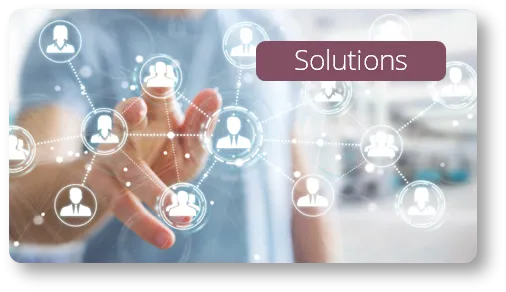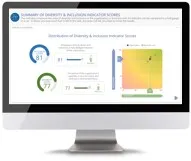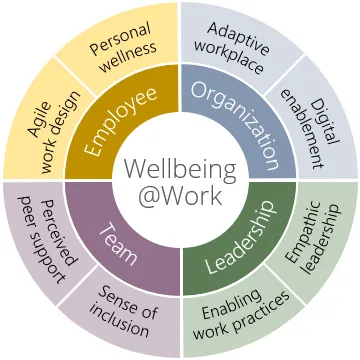
Mindset's Employee Wellbeing Survey
Creating a hybrid human-centric working environment that ensures performance, innovation and equity
Healthy organizations embrace a more human-centric work model – based on flexibility, performance, innovation, and equity – and a more holistic employee wellness focus than ever before
Research by Bersin (The Healthy Organization: Next Big Thing In Employee Wellbeing) found that while companies with a more holistic approach towards wellbeing spend much more money on health and wellbeing, they by far outperform their peers. According to Bersin, healthy organizations are:
| 11x |
lower absenteeism
11 times more likely to have low levels of absenteeism
220%
meeting targets
220% more likely to be meeting their financial targets
| 540% |
recruiting top people
540% more effective at recruiting top people
Challenges Organizations Face in These Times
Organizations are currently faced with the task of redefining what their new workplace will look like post the COVID-19 pandemic. Given the rollout of vaccinations globally, employees can return to work, but work as we knew it pre-COVID has changed completely.
For most organizations the pandemic has resulted in changes in their working patterns, so they are re-evaluating their operations and considering a combination of remote and on-site working, referred to as a hybrid model. Unfortunately this doesn't just mean accepting remote working and moving site-centric practices like meetings to virtual spaces. As Gartner describes it, the new hybrid working environment needs to be reinvented around a human-centric design that ensures performance, innovation and equity.
This will not happen over-night however— it will require organizations to experiment, learn and iterate a working model by testing it and getting feedback from employees. Employees may be concerned about the safety and hygiene of their offices, or whether they might be negatively impacted by working from home due to isolation from more traditional interactions with colleagues and bosses. Organizations may not want to adopt any remote working models or, on the other hand, may embrace distributed work and face challenges when it comes to onboarding employees, performance management or investing in and enforcing data security.
Mindset's Wellbeing@Work Employee Wellbeing Model
There is a need to evolve the work model and reinvent work around a more human-centric design that not only ensures performance, innovation and equity, but most importantly drives a more holistic focus on employee wellness than ever before. To ensure that workers are thriving and are engaged in the new way of working, it is important to look at areas in the organization that cause unnecessary stress while at the same time to providing workers with the support and resources they need.
 |
Demo version of the Wellbeing@Work employee wellbeing dashboard (desktop only) |
The Wellbeing@Work survey will help organizations to navigate the future of work by continually assessing the move towards the new way of work, and adjusting their approach through experimentation, learning and iterating. The factors that impact employee wellbeing can be viewed from an organizational, leadership, team and employee level, as outlined below.
 Organizational level
Organizational level
From an organizational perspective, the ideal work environment will include norms around an adaptive workplace where the right balance is found between an overly tight or loose culture, known as tight–loose ambidexterity. Successful organizations will benefit from having flexible tightness, with rules that bind employees together to prevent social isolation and loneliness, that are accompanied by the right dose of looseness to afford employees with the flexibility necessary to get things done.
- Adaptive Workplace – an adaptive workplace finds the right balance in a hybrid work environment where employees have autonomy where practical, as well as enough rules to bind the workforce together and prevent them from feeling isolated. An adaptive workplace also provides equality of opportunity for all employees, whether working from home, working at the office, or working from somewhere else, or any combination.
- Digital Enablement – organizations can no longer just rely on the technology that enables employees to work from the office, but now need to establish the technologies and practices necessary to optimize a hybrid work model that will enable employees to work safely and efficiently from anywhere. Employees now need to have the tools necessary to collaborate effectively with their colleagues, no matter where they are working from.
Leadership level
From a leadership perspective, the effective working environment requires leaders that are inspirational, have the skills and competencies to effectively manage in a hybrid environment, understand how to monitor outcome-based measurements - leaders who drive empathy-based management and mentoring.
- Enabling Work Practices – employees must be enabled through upskilling so they will keep up with future digital needs while meeting business goals. Employees will require mentoring, coaching as well as training, not only on how to communicate effectively in a post-pandemic hybrid environment, but also on how their performance will be evaluated in the new way of working. This upskilling provides a sense of greater mastery of one’s role and profession.
- Empathic Leadership – involves managers and leaders who have a genuine interest in their team members' lives, the challenges they face, and their overall feelings – the kind of leader who makes an effort to understand their situations and what they are going through in order to provide support and help. Empathic leaders will create a more human-centric atmosphere in the post-pandemic workplace, will be transparent and open to feedback and informal conversations, and will foster a greater understanding of the organizational mission so that workers develop a sense of connected autonomy at work.
Team level
From a team perspective, the Wellbeing survey model considers the extent at which team members experience a sense of belonging in the organization. Teams are enabled when individual members experience a sense of acceptance, trust, security and support from other team members that allows them to authentically participate, contribute and feel included.
- Perceived Peer Support – teams are enabled when there is a sense of support and trust between team members.
- Sense of Inclusion – teams are enabled when there is a sense of acceptance between team members and they feel included and involved in team activities.
Employee level
From an employee perspective, wellbeing will be driven by an inclusive, caring and healthy work environment that is designed to upskill as well as empower employees so they have more control over their work and their work environment – a responsive and agile work environment that will allow them to shift between workplaces so they and their teams are most productive.
- Personal Wellness – deals with an individual’s ability to cope with the new situation at work and the potential hybrid scenarios. It is important that employees do not feel any sense of isolation, have healthy levels of stress, don’t experience any fear at work, and have access to health resources from wherever they need access. Employers also have to incentivize healthy behaviors throughout the organization.
- Agile Work Design – there is a specific need for a responsive, agile and flexible work environment where roles and structures are designed around outcomes – and in the process provide employees with adaptive and flexible roles so they can acquire cross-functional training and skills.
